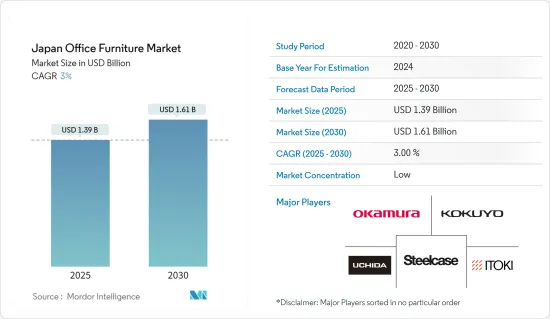|
|
市場調査レポート
商品コード
1643002
日本のオフィス家具:市場シェア分析、産業動向・統計、成長予測(2025年~2030年)Japan Office Furniture - Market Share Analysis, Industry Trends & Statistics, Growth Forecasts (2025 - 2030) |
||||||
カスタマイズ可能
適宜更新あり
|
|||||||
| 日本のオフィス家具:市場シェア分析、産業動向・統計、成長予測(2025年~2030年) |
|
出版日: 2025年01月05日
発行: Mordor Intelligence
ページ情報: 英文 150 Pages
納期: 2~3営業日
|
全表示
- 概要
- 目次
日本のオフィス家具の市場規模は2025年に13億9,000万米ドルと推計され、予測期間中(2025-2030年)のCAGRは3%で、2030年には16億1,000万米ドルに達すると予測されます。

日本のオフィス家具市場は、今後数年間で大幅な成長が見込まれます。この急成長の背景には、雇用情勢の上昇とオフィススペースに対する需要の急増があり、これがオフィス家具に対する日本のニーズを後押ししています。日本は、中国やインドと並んで、アジア太平洋市場においてオフィス家具の製造と消費の両面で重要な役割を担っています。アジア太平洋地域が日本のオフィス家具の主要な輸出拠点である一方、北米もそれに迫る勢いを見せています。
官公庁や民間企業のオフィスが拡大し、地域の労働人口が増加するにつれて、日本のオフィス家具の需要は増加傾向にあります。特筆すべきは、市場が人間工学に基づいた使いやすい家具に軸足を置き、従業員の姿勢に関する懸念に対応していることです。
日本の政府機関は職場の安全性とアクセシビリティを積極的に提唱しており、オフィス家具のアップグレードを義務付けることも多いです。多様な専門職や新興企業の顧客に対応するコワーキングスペースの人気が急上昇していることも、適応性の高い家具ソリューションへのニーズをさらに押し上げています。さらに、利便性、迅速な出荷、割引、多様な支払いオプションを提供するオンラインショッピングアプリへの嗜好の高まりも、市場を大きく押し上げると予想されます。
大手企業は、生産的で快適なワークスペースを作るため、オフィスのインテリアや家具に多額の投資を行っています。同時に、多くの家具メーカーやデザイナーは、従業員のストレスを軽減することを目的に、快適さを優先した椅子に磨きをかけています。市場の成長は、スマート家具の採用が増加していることによってさらに後押しされています。
日本のオフィス家具市場動向
日本のオフィス建設がオフィス家具の需要を促進
日本におけるオフィス家具の需要は、オフィス建設の急増、ベンチャー企業の台頭、労働力不足への対応などを背景に増加傾向にあります。企業は、現在のオフィスを改装するだけでなく、新たなオフィススペースに投資したり、シェアオフィスを導入したりしており、これらすべてがオフィス家具へのニーズを高めています。この変化は、特に東京のような大都市中心部で顕著であり、大規模オフィスビルの数は着実に増加しています。
今年完成予定の東京ワールドゲート赤坂プロジェクトは、20万8,000平方メートルという広大な面積を誇り、東京23区最大のオフィスプロジェクトとしてリードしています。
事業拡大の中、オンラインチャネルがオフィス家具販売を促進
ビジネスの拡大と従業員の増加に伴い、オフィス家具の需要が急増しています。豊富な品ぞろえ、価格比較のしやすさ、スムーズな配送といった利点に惹かれ、オフィス家具の調達にオンライン・プラットフォームを選択する企業が増えています。このシフトは、実店舗に足を運ぶ必要性をなくすだけでなく、顧客に豊富な選択肢を提供します。さらに、オンライン小売企業はコストを巧みに削減し、収益性を高めています。その結果、オンライン家具販売店への嗜好の高まりが、今後数年間の市場成長を牽引するものと思われます。
日本のオフィス家具産業の概要
日本のオフィス家具市場は半固定的です。日本のオフィス家具市場は一握りの主要企業によって支配されており、岡村製作所、コクヨ、イトーキ、内田洋行の上位4社が市場シェアの50%以上を占めています。特筆すべきは、スチールケースやハーマンミラーといった世界的大手がこの市場に進出していることです。興味深いことに、この市場では現在、無印良品を含む家庭用家具メーカーがオフィス家具分野に進出しています。このような新たなプレーヤーの参入は、業界の競争を激化させる構えです。
その他の特典:
- エクセル形式の市場予測(ME)シート
- 3ヶ月間のアナリストサポート
目次
第1章 イントロダクション
- 調査の成果 と市場定義
- 調査範囲
第2章 調査手法
第3章 エグゼクティブサマリー
第4章 市場力学と洞察
- 市場概要
- 市場促進要因
- 新規オフィス建設の増加
- 近代的な家具への志向の高まりが市場を促進する見込み
- 市場抑制要因
- 様々な環境問題による原材料価格の高騰が市場拡大の妨げになる見込み
- 市場機会
- 企業による革新的な新製品のイントロダクション
- 小売店舗とオンライン・プラットフォームの拡大
- ポーターのファイブフォース分析
- 新規参入業者の脅威
- 買い手・消費者の交渉力
- 供給企業の交渉力
- 代替品の脅威
- 競争企業間の敵対関係の強さ
- 業界の技術的進歩に関する洞察
- COVID-19の市場への影響
第5章 市場セグメンテーション
- 材料別
- 木材
- 金属
- プラスチック
- その他の材料
- 製品別
- ミーティングチェア
- ラウンジチェア
- 回転チェア
- オフィステーブル
- 収納キャビネット
- デスク
- 流通チャネル別
- マルチブランド店
- 専門店
- オンライン・プラットフォーム
- その他の流通チャネル
第6章 競合情勢
- 市場競争の概要
- 企業プロファイル
- Okamura Corporation
- Kokuyo
- Itoki
- Uchida Yoko
- Kurogane
- Steelcase
- Herman Miller
- Haworth
- HNI Corporation
- Bene
- Sedus Stoll
- Martela
- Scandinavian Business Seating
第7章 市場動向
第8章 免責事項と出版社について
The Japan Office Furniture Market size is estimated at USD 1.39 billion in 2025, and is expected to reach USD 1.61 billion by 2030, at a CAGR of 3% during the forecast period (2025-2030).

The Japanese office furniture market is poised for substantial growth in the years ahead. This surge is underpinned by a rising employment landscape and a surging demand for office spaces, collectively bolstering the nation's need for office furniture. Japan, alongside China and India, stands out as a key player in both manufacturing and consuming office furniture within the Asia-Pacific market. While Asia and the Pacific are primary export hubs for Japanese office furniture, North America is emerging as a close contender.
As public and private corporate offices expand and the regional workforce grows, the demand for office furniture in Japan is on the rise. Noteworthy is the market's pivot toward ergonomic and user-friendly furniture, addressing employee posture concerns.
Japanese government bodies are actively championing workplace safety and accessibility, often leading to mandates for office furniture upgrades. The surge in popularity of coworking spaces, catering to a diverse professional and startup clientele, is further propelling the need for adaptable furniture solutions. Additionally, the market anticipates a significant boost from the growing preference for online shopping apps, which offer convenience, swift shipping, discounts, and varied payment options.
Major corporations are channeling significant investments into office interiors and furnishings to craft productive and comfortable workspaces. Concurrently, many furniture manufacturers and designers are honing in on chairs that prioritize comfort, aiming to alleviate employee stress. The market's growth is further bolstered by the rising adoption of smart furniture.
Japan Office Furniture Market Trends
Thriving Office Construction in Japan Fueling Demand for Office Furniture
The demand for office furniture in Japan is on the rise, propelled by a surge in office construction, the rise of new venture capital firms, and efforts to address labor shortages. Companies are not just sprucing up their current offices but also investing in new office spaces and embracing shared setups, all of which are driving the need for office furniture. This shift is especially noticeable in major urban centers like Tokyo, where the number of large office buildings is steadily climbing.
Tokyo's 23 special wards, unique administrative units within the city, are witnessing a boom in new office constructions, many exceeding 10,000 sq. m. The Tokyo World Gate Akasaka project, set for completion in the current year, has taken the lead as the largest office project in these wards, covering an expansive 208,000 sq. m. Following closely is the Toda Building in Tokyo's Chuo Ward, spanning 94,800 sq. m. With this momentum in office construction, the Japanese office furniture market is set for continued growth.
Online Channels Propelling Office Furniture Sales Amid Business Expansion
As businesses expand and their workforces grow, the demand for office furniture is surging. Increasingly, companies are opting for online platforms to procure office furniture, enticed by their benefits, such as a wide product selection, easy price comparisons, and seamless deliveries. This shift not only obviates the need for physical store visits but also grants customers a plethora of choices. Moreover, online retailers have adeptly trimmed costs, enhancing their profitability. As a result, the escalating preference for online furniture outlets is set to drive market growth in the coming years.
Japan Office Furniture Industry Overview
The office furniture market in Japan is semi-consolidated. The Japanese office furniture market is dominated by a handful of key players, with the top four companies, Okamura Corporation, Kokuyo, Itoki, and Uchida Yoko, holding over 50% of the market share. Notably, global giants like Steelcase and Herman Miller have made their mark on this market. Interestingly, the market is now seeing a foray of home furniture companies, including MUJI, venturing into the office furniture segment. This influx of new players is poised to intensify competition in the industry.
Additional Benefits:
- The market estimate (ME) sheet in Excel format
- 3 months of analyst support
TABLE OF CONTENTS
1 INTRODUCTION
- 1.1 Study Deliverables and Market Definition
- 1.2 Scope of the Study
2 RESEARCH METHODOLOGY
3 EXECUTIVE SUMMARY
4 MARKET DYNAMICS AND INSIGHTS
- 4.1 Market Overview
- 4.2 Market Drivers
- 4.2.1 Increase in the Construction of New Offices
- 4.2.2 Growing Inclination Toward Modern Furniture Expected to Fuel the Market
- 4.3 Market Restraints
- 4.3.1 Fluctuating Prices of Raw Materials due to Various Environmental Concerns Expected to Hamper Market Expansion
- 4.4 Market Opportunities
- 4.4.1 Introduction of New and Innovative Products by Companies
- 4.4.2 Expansion of Retail Outlets and Online Platforms
- 4.5 Porter's Five Forces Analysis
- 4.5.1 Threat of New Entrants
- 4.5.2 Bargaining Power of Buyers/Consumers
- 4.5.3 Bargaining Power of Suppliers
- 4.5.4 Threat of Substitute Products
- 4.5.5 Intensity of Competitive Rivalry
- 4.6 Insights into Technological Advancements in the Industry
- 4.7 Impact of COVID-19 on the Market
5 MARKET SEGMENTATION
- 5.1 By Material
- 5.1.1 Wood
- 5.1.2 Metal
- 5.1.3 Plastics
- 5.1.4 Other Materials
- 5.2 By Product
- 5.2.1 Meeting Chairs
- 5.2.2 Lounge Chairs
- 5.2.3 Swivel Chairs
- 5.2.4 Office Tables
- 5.2.5 Storage Cabinets
- 5.2.6 Desks
- 5.3 By Distribution Channel
- 5.3.1 Multi-branded Stores
- 5.3.2 Specialty Stores
- 5.3.3 Online Platforms
- 5.3.4 Other Distribution Channels
6 COMPETITIVE LANDSCAPE
- 6.1 Market Competition Overview
- 6.2 Company Profiles
- 6.2.1 Okamura Corporation
- 6.2.2 Kokuyo
- 6.2.3 Itoki
- 6.2.4 Uchida Yoko
- 6.2.5 Kurogane
- 6.2.6 Steelcase
- 6.2.7 Herman Miller
- 6.2.8 Haworth
- 6.2.9 HNI Corporation
- 6.2.10 Bene
- 6.2.11 Sedus Stoll
- 6.2.12 Martela
- 6.2.13 Scandinavian Business Seating*





